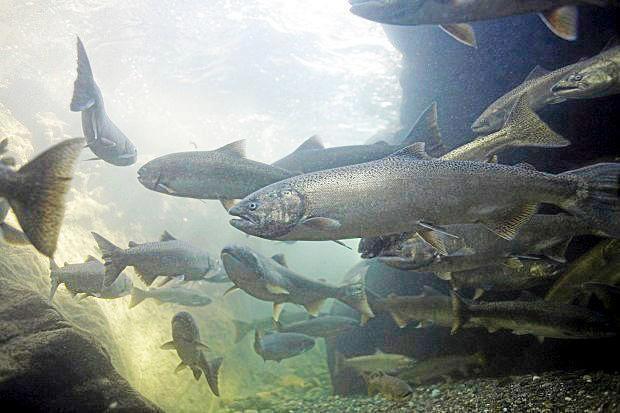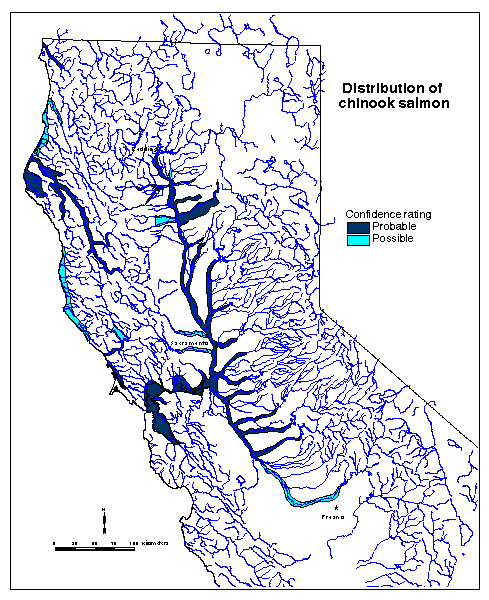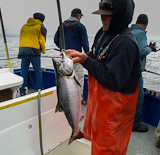Interesting Facts
Chinook is the name of a large tribe of Native Americans that lived along the Columbia River.
In North America chinook once spawned as far east as Montana and as far south as Nevada.
Chinook Salmon - Kings
Chinook are the largest of the Pacific salmon - earning their nickname "king salmon." The lifespan of a chinook ranges from about 3 to 6 years. Fully mature adults spawn in mainstem rivers. Surprisingly, these large salmon process the strength and agility to reach into small and swallow tributaries to spawn as well. These tributaries ultimately provide excellent nurseries for the newly emerging salmon with food and shelter from the largest predators.
Adult spawners are colored olive brown to dark maroon. Spawning males are darker than females and have the signature hooked jaws and more of a pronounced hump in their back.
Within the genus Oncorhynchus, chinook salmon are most closely related to coho salmon. As a species, chinook classification breaks down into separate populations commonly referred to as runs. These runs or stocks vary genetically largely due to adaptations to habitat. California historically supported over 20 separte runs of chinook.
The Klamath River Chinook Runs
The widely acknowledged chinook runs within the Klamath basin are:
- Klamath-Trinity fall run
- Klamath-Trinity spring run
- Klamath-Trinity late fall run
If you recognize the tributary runs within the Klamath basin as having uniquie genetics and life histories, then the total increases to nine.

Distribution in the Klamath River
Within the Klamath basin, chinook salmon migrated as far as the Upper Klamath Lake in Oregon. From Klamath Lake they dispersed into all the lake's major tributaries to spawn including Sprague, Williamson and Wood Rivers. The upper reaches of the basin were ascended during the higher flow months of spring - thus critical habitat to the Klamath spring run.
Female chinook commonly build their nests, or redds on streams feeding the mainstem Klamath. These streams include Bogus Creek, Shasta River, Scott River, Indian Creek, Elk Creek, Clear Creek, Salmon River, Bluff Creek, and Blue Creek. The Salmon River including it's major forks and Wooley Creek are especially critical habitat to the Klamath's remaining spring run.
Fall Run Chinook
Fall run chinook have adapted to spawn in the lower reaches of big rivers such as the Klamath. As mature adults, they typically enter the Klamath from the ocean in late summer and early fall. Since they spawn in the lower portion of the river, the females can finish building her redd within weeks. Incubation ranges from 5 to 10 weeks. The tiny salmon reside in the gravel beds for several weeks depending on water temperature. The juveniles initially seek shallow water and slow current to finish absorbing their yolk sac. Next, these salmon swim into the more open water of the stream to feed on plankton and other small aquatic insects.
As chinook populations go, the fall runs settle along the best quality spawning and rearing habitat within the low reaches of a river. Their early fall spawning cycle also avoids the higher water temperatures of summer. The historic abundance of fall run chinook in the Klamath atests to the success of their life history.
Spring Run Chinook
The spring run chinook migration period ranges from March to September. The Klamath's spring run historically migrated as far as 450 km to reach the tributaries of the Upper Klamath in Oregon where they held for several months in deep, cold pools. Throughout late summer and early fall, these fish spawned. Their life history exploited an opportunity to reach the higher and cooler water of the basin in the spring when flows in the lower and middle sections ran high and cool.
As a result of their strategy, spring run chinook equaled their fall run counterparts in abundance. That is, before dams blocked their historical spawning grounds in the upper Klamath.
Photo of California Golden Trout by P. Michael Carl © The Ecological Angler


